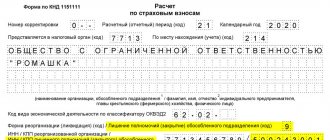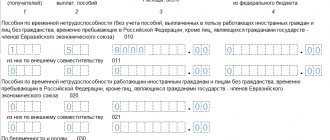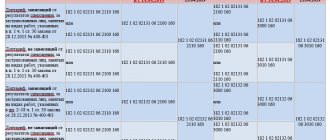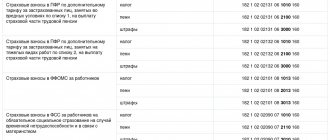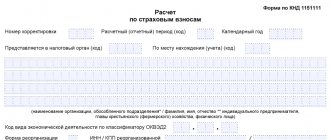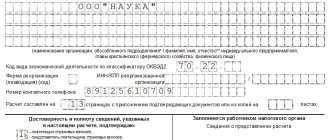Calculation of vacation pay in 2021. 5 Mistakes to Avoid
Errors in calculating vacation pay can result in the employee receiving more or less than the required amount.
They paid more - they inflated labor costs, threatening liability for the company. If they paid less, they offended the employee and violated his rights. Let's look at the 5 main mistakes of an accountant. The procedure for calculating average earnings when determining vacation pay is regulated by Decree of the Government of the Russian Federation of December 24, 2007 No. 922 (hereinafter referred to as Regulation No. 922).
You will find a step-by-step calculation of vacation pay in the article “How to correctly calculate vacation pay in 2021.” Examples and calculation calculator." Next is error analysis.
Errors when calculating vacation pay
Error No. 1. The calculation period for vacation pay is incorrectly determined
The reason for this error lies in the fact that the accountant incorrectly interprets the norm of paragraph 5 of Regulation No. 922. The time that must be excluded from the calculation is indicated here.
When calculating average earnings, time is excluded from the calculation period, as well as amounts accrued during this time, if:
- the employee retained his average earnings in accordance with the legislation of the Russian Federation, with the exception of breaks for feeding the child. Taking breaks to feed the baby cannot be ruled out!
- the employee received temporary disability benefits or maternity benefits;
- the employee did not work due to downtime due to the fault of the employer or for reasons beyond the control of the employer and employee. Downtime caused by the employee cannot be ruled out!
- the employee did not participate in the strike, but due to this strike he was unable to perform his work. We cannot rule out a time when the employee participated in a strike!
- the employee was provided with additional paid days off to care for disabled children and people with disabilities since childhood;
- in other cases, the employee was released from work with full or partial retention of wages or without payment in accordance with the legislation of the Russian Federation.
If at the time of calculating vacation pay in the billing period there are employee absences from work, the reasons for which have not been clarified, it is also unlawful to exclude this time. The same goes for absenteeism. This fully complies with the norms of clause 5 of Regulation No. 922.
How to avoid mistake #1:
The following cannot be excluded from the calculation period:
- breaks for feeding the baby;
- downtime due to the fault of the employee;
- the time when the employee participated in the strike;
- absences for unknown reasons;
- absenteeism.
Error No. 2. The organization has adopted a billing period of less than 12 months, which worsens the situation of employees
The average earnings of an employee, regardless of his mode of work, are calculated based on the wages actually accrued to him and the time actually worked by him for the 12 calendar months preceding the period during which the employee retains his average wage (clause 4 of Regulation No. 922).
A collective agreement or local regulatory act may provide for other periods for calculating average wages, if this does not worsen the situation of workers (Article 139 of the Labor Code of the Russian Federation). Please note that the key words are “if it does not worsen the situation of workers.”
How to avoid mistake #2:
Let’s say that an organization’s local regulations provide for a different billing period, for example 4 months. Before paying vacation pay to an employee, the accountant must calculate vacation pay two times:
- from the previous 12 months;
- from the period established by local regulations.
If the vacation pay calculated from the previous 12 months turns out to be more, then it should be paid.
Error No. 3. Payments made during the billing period are incorrectly included in the calculation of vacation pay.
To calculate average earnings, all types of payments provided for by the remuneration system and applied by the relevant employer are taken into account, regardless of the sources of these payments (clause 2 of Regulation No. 922). Key words: “provided for by the remuneration system.”
- The calculation of average earnings includes payments that are not made for labor. Payments that do not relate to salary cannot be included in the calculation. Let us remind you what salary is. Salary is a remuneration for work depending on the qualifications of the employee, the complexity, quantity, quality and conditions of the work performed, as well as compensation payments (additional payments and allowances of a compensatory nature, including for work in conditions deviating from normal, work in special climatic conditions and in territories exposed to radioactive contamination, and other compensation payments) and incentive payments (additional payments and incentive allowances, bonuses and other incentive payments) (Article 129 of the Labor Code of the Russian Federation).
- The calculation of vacation pay includes payments that are not provided for by the company’s local regulations.
How to avoid mistake #3:
- When calculating your average earnings, do not include vacation payments that are not wages, but payments for labor. For example, an incentive payment for an employee’s 50th birthday is not a salary, it cannot be included in the calculation of vacation pay - this is not legally justified;
- Fix in the company’s local regulations the payments included in the calculation of vacation pay, for example, in the Regulations on Remuneration.
Error No. 4. The calculation of vacation pay includes all bonuses accrued to the employee in the pay period without exception.
Examples of errors. The calculation of vacation pay includes:
- Awards that are not provided for by local regulations.
- Bonuses that are paid to an employee not for work: for example, for an anniversary or a professional holiday.
- Annual bonuses for the year not preceding the calculation of vacation pay. An example of an incorrect inclusion of an annual bonus: an employee goes on vacation in March 2021. Two annual bonuses were accrued in the billing period: in March 2021 for 2021 and in January 2021 for 2019. The 2021 premium was higher than the 2021 premium. The accountant included the bonus for 2021 in the calculation of average earnings, since it is larger. This is illegal. According to clause 15 of Regulation No. 922, remuneration based on the results of work for the year, a one-time remuneration for length of service (work experience), other remunerations based on the results of work for the year, accrued for the calendar year preceding the event, are included regardless of the time the remuneration was accrued.
- Without exception, all monthly, quarterly, semi-annual bonuses accrued in the billing period. An example of an incorrect inclusion of a quarterly bonus: in a billing period of 12 months, an employee was awarded five quarterly bonuses for the same indicator. All five premiums were included in the calculation. The accountant did this, arguing that all these bonuses were accrued in the billing period. This is illegal. According to clause 15 of Regulation No. 922, no more than 4 quarterly bonuses for the same indicator can be included. The same applies to monthly and semi-annual bonuses.
How to avoid mistake #4:
In calculating average earnings when calculating vacation pay, you should include:
- only bonuses provided for by local regulations;
- only bonuses for labor ;
- no more than 12 monthly, 4 quarterly, 2 semi-annual bonuses accrued in the billing period for the same indicator;
- annual bonus only for the calendar year preceding the event, regardless of the time of accrual.
Error No. 5. Incorrectly applied the increase factor when calculating vacation pay
An example of an error: when calculating an employee’s vacation pay, the average salary is calculated taking into account the increase factor, although the salary increase affected only this employee.
Important Exceptions
Despite the apparent simplicity of calculating the average flow rate, the formula contains a lot of nuances. Thus, the calculation of the indicator cannot include a whole list of payments due from the employer to the employee. These include financial assistance, payments in connection with the deterioration of the health of the employee or his loved one, payments in the event of the death of a family member, and so on. Such amounts are never taken into account in calculating average income. The same rule applies to vacation pay. Note that the inclusion of vacation pay in average income is the most common mistake accountants make in calculating the indicator. The fact is that the vacation payments themselves are calculated based on the average value, but in no case should they be included in the calculation itself. This group also includes travel payments, which are not taken into account when calculating the average employee’s income.
Another type of payment not taken into account in the calculations is hospital payments. They are of a compensatory nature and are paid to the employee in accordance with the issued certificate of incapacity for work. This means that they are not related to wages and are not taken into account in calculating average values. In some cases, employees of organizations are entitled to various compensations. This could be payment for travel and food, communications, gasoline, accommodation, etc. All these payments are also not earnings, and therefore cannot be included in the calculation of average income.
note
In accordance with Russian legislation, if a company provides employees with bonuses or other payments not directly related to work activities, they cannot be included in the calculation of average income values.
The formula for an employee's average daily earnings is as follows:
SDZ = DR/VR
, Where
SDZ
– average daily earnings;
DR
– employee income;
VR
– working time in the number of days actually worked during the billing period.
Example
Let's consider an example of calculating maternity benefits based on the average earnings of an employee. The employee will go on maternity leave for 140 calendar days from January 23, 2021. Payments taken into account: in 2021 - 590,000 rubles, in 2021 - 700,000 rubles. She had no periods excluded when calculating average daily earnings. Let's determine the actual average daily earnings: 1,767.12 rubles (590,000 rubles +700,000 rubles) / 730 days. It does not exceed the maximum earnings (2,017.81 rubles) and more than the minimum (370.85 rubles). Therefore, for the calculation we take the actual daily earnings. The benefit will be 247,396.80 rubles: (1,767.12 rubles × 140 days × 100%).
How to correct errors when calculating vacation pay
You have discovered an error when calculating vacation pay. What to do? First, figure out whether vacation pay is overestimated or, conversely, underestimated:
- Vacation pay is underestimated—add up and pay the employee the missing amount.
- Vacation pay is overstated (the accountant incorrectly applied the law) - in this case, it is impossible to simply withhold vacation pay overpaid to the employee, since the error occurred due to incorrect application of the law. The employee must give his consent.
You can contact the employee with a request that he write a statement to withhold this amount. If the employee agrees, the overpaid amount can be withheld in full. This deduction will already be considered as a deduction at the initiative of the employee, and there are no restrictions here.
But if the employee refuses, then the overpaid vacation pay can only be returned through the courts.
What is included in average earnings
Many payments due to employees in accordance with labor legislation are calculated based on average earnings: vacation pay, compensation for unused vacation, payment for days on a business trip, etc. When calculating average earnings, all payments provided for by the remuneration system are taken into account (clause 2 of the Regulations, approved by Decree of the Government of the Russian Federation of December 24, 2007 N 922). This is, of course, a general formulation. Therefore, let’s try to understand in more detail what is included in the average earnings, that is, what payments should be taken into account when calculating it.
Let us immediately make a reservation that in this case the procedure for calculating average earnings for the purposes of determining the amount of benefits, as well as drawing up a certificate to the employment service, is not considered.
What is included in the average salary
So, what payments are included in the calculation of average earnings? First of all, salary. And in all its “manifestations”. In other words, the salary accrued to the employee (clauses “a” - “c”, paragraph 2 of the Regulations, approved by Decree of the Government of the Russian Federation of December 24, 2007 N 922):
- for time worked at tariff rates, salaries;
- for work performed at piece rates;
- for work performed as a percentage of revenue from product sales or in the form of a commission.
- allowances and additional payments to tariff rates and salaries - for length of service, length of service, combination of professions, team management, etc.;
- payments related to working conditions. For example, increased wages for heavy work, for night work, etc.;
- bonuses and rewards in accordance with the remuneration system.
Composition of the indicator
Before the accountant begins calculating average earnings, he needs to decide on the list of payments that will be included in this indicator. It is also necessary to select the reporting period for which the specified value will be calculated. The first and main value for calculating average earnings is salary. It must be taken into account not in the amount fixed in the employment contract, but in the amount that was actually paid for the days worked. Another meaning is the tariff rate. The fact is that working on a piecework system or other forms in any case requires the inclusion of all funds directly earned by the employee in the calculation of the average salary.
Various types of allowances, including those associated with regional coefficients, are required to be included in the calculation of average earnings. Thus, if an employee receives additional payments for work, for example, in the Far North, in hazardous industries or on a rotational basis, his average income will be calculated taking into account these payments. Particular attention should be paid to bonuses. The fact is that their size, as a rule, varies from period to period; all types of bonuses paid to the employee must be taken into account.
Separately, it is worth considering the employee’s income received in kind. Legislation allows enterprises to provide part of their wages with their own products. The main thing is that such employee income is also taken into account in calculating average earnings. Market prices must be used to determine the value of goods received.
What is not included in the average salary calculation
To calculate the average salary, payments that are not related to the wage system, including those of a social nature, are not taken into account. In other words, amounts that do not correspond to the concept of “wages” prescribed in the Labor Code of the Russian Federation (Article 129 of the Labor Code of the Russian Federation). This is financial assistance, payment of the cost of food to employees, travel, training (clause 3 of the Regulations, approved by Decree of the Government of the Russian Federation dated December 24, 2007 N 922), additional payment up to average earnings when paying temporary disability benefits (Letter of the Ministry of Labor dated August 3, 2016 N 14 -1/OOG-7105) etc.
What is not included in the average base
To calculate average earnings, social payments and other payments not related to wages (material assistance, payment for the cost of food, travel, training, utilities, recreation, etc.) are not taken into account.
(Clause 3 of the Regulations on the specifics of the procedure for calculating average wages)
When calculating average earnings, time is excluded from the calculation period, as well as amounts accrued during this time, if:
- the employee retained his average earnings in accordance with the legislation of the Russian Federation (with the exception of breaks for feeding the child);
- the employee received temporary disability benefits or maternity benefits;
- the employee did not work due to downtime due to the fault of the employer or for reasons beyond the control of the employer and employee;
- the employee did not participate in the strike, but due to this strike he was unable to perform his work;
- the employee was provided with additional paid days off to care for disabled children and people with disabilities since childhood;
- in other cases, the employee was released from work with full or partial retention of wages or without payment in accordance with the legislation of the Russian Federation.
(Clause 5 of the Regulations on the specifics of the procedure for calculating average wages)
Did the article help?
Get another secret bonus and full access to the BukhExpert8 help system for 14 days free of charge
Related publications
- Question for Svetlana Zmievskaya: Is it possible to set up the “Payment in kind” type of calculation so that it is not included in the base for calculating average earnings for sick leave. Good afternoon, the organization pays employees income in kind...
- Adding average earnings to the bonus calculation database for the previous period Good afternoon. One of my questions was answered with an interesting...
- Why, when calculating vacation pay, are not accruals for internal part-time jobs included in the base for calculating average earnings? ...
- Information for calculating total average earnings should be taken into account for calculating benefits and vice versa (ZUP 3.0.24) ...
Are vacation pay and travel allowances taken into account when calculating average earnings?
Vacation pay is not taken into account when calculating average earnings, since they are paid for the excluded period - the time of annual leave (clause “a”, clause 5 of the Regulations, approved by Resolution of the Government of the Russian Federation of December 24, 2007 N 922, Letter of the Ministry of Labor dated April 15, 2016 N 14-1 /B-351 ).
And if you are wondering whether business trips are included in the calculation of average earnings, then the situation with them is the same as with vacation pay. Not included, since the time spent on a business trip refers to excluded periods (Letter of the Ministry of Labor dated August 13, 2015 N 14-1/B-608).
To calculate your average earnings, you can use our Calculator.
Officials' opinion
And yet accountants still have a lot of questions related to calculating average earnings. Thus, recently the Ministry of Finance provided clarification on the issue of personal income tax on the income of an employee sent on a business trip outside the Russian Federation if he has lost his status as a resident of the Russian Federation. In a letter dated May 16, 2021 No. 03-04-05/35316, officials reported that according to paragraph 2 of Article 207 of the Tax Code of the Russian Federation, tax residents of the Russian Federation are individuals who are actually in Russia for at least 183 calendar days over the next 12 consecutive months. At the same time, remuneration for performing labor duties outside the country refers to income from sources outside of Russia (subclause 6, clause 3, article 208 of the Tax Code of the Russian Federation).
When an employee goes on a business trip, he is guaranteed to maintain his average earnings. The rule is fixed in Article 167 of the Labor Code of the Russian Federation. Thus, during the period of stay outside Russia, the company pays the employee an average salary. It is worth noting that such payments made by a Russian enterprise when sending an employee on a business trip are not remuneration for the performance of work duties outside the Russian Federation, and therefore relate to income from Russian sources. If an employee was in the Russian Federation for more than 183 days during the year before receiving income, then he will be recognized as a resident. This means that a tax of 13% will be withheld from his average earnings. Whereas non-residents will have to pay 30% to the treasury.
Vacation pay calculation
The amount of vacation pay is calculated as the product of the average daily earnings and the number of days of vacation provided.
The duration of basic paid leave is 28 calendar days. Leave may be granted in full or may be divided into parts, but one of them should not be less than 14 days.
Payments taken into account when calculating vacation pay
When calculating average earnings, social payments are not taken into account,
Billing period
The pay period does not include the time when the employee:
- received benefits for temporary disability or maternity benefits;
- had the right to average earnings in accordance with labor legislation (was on vacation or on a business trip). The only exception is that the employee is entitled to average earnings during breaks to feed the child, but this time is not excluded from the billing period;
- did not work due to downtime due to the fault of the employer or for reasons beyond the control of management or staff;
- was released from work for other reasons provided for by law (for example, leave without pay).
Formula 1 for calculating average daily earnings for vacation pay
ZPsr. = ZPf. / 12 months / 29.3
Before April 2, 2014, the average monthly number of calendar days was = 29.4
The employee goes on another paid vacation for 14 calendar days in April 2014. Earnings for the billing period are 780,000 rubles. For the calculation, the accountant used a coefficient of 29.4
and the average daily earnings amounted to 2,210.8843 rubles. (RUB 780,000: 12 months: 29.4). The amount of vacation pay amounted to RUB 30,952.38. (RUB 2210.8843 x 14 days).
If we apply the new coefficient of 29.3
, then the average daily earnings will be a little more and will be 2,218.4300 rubles. (RUB 780,000: 12 months: 29.3). This means that vacation pay will be greater, namely 31,058.02 rubles. (RUB 2,218.48 x 14 days). Accordingly, the difference in vacation pay due to the coefficients will be 132.64 rubles. (RUB 31,058.02 – RUB 30,925.38).
The employee went on vacation on July 1, 2010 for 14 days. The billing period for its payment is from 07/01/2009 to 06/30/2010. In the billing period, the employee was accrued wages accepted for calculation - 85,000 rubles. The amount of vacation pay should be calculated.
The amount of vacation pay for 14 calendar days will be RUB 3,373.02.
(RUB 85,000 / 12 months / 29.4 days x 14 days).
Formula 2 for calculating average daily earnings for vacation pay
If one or more months of the billing period are not fully
or the time when the employee was accrued average earnings was excluded from this period
ZPsr. = ZPf. / (29.3 x Mpcm + Dncm)
where: Mpkm – the number of full calendar months worked; Dnkm – the number of calendar days in incomplete calendar months.
The number of calendar days in an incomplete calendar month is calculated as follows:
The employee went on vacation for 28 days. from 07/10/2010. During the billing period (01.07.2009 – 30.06.2010) from August 15 to 17, 2009, he was on sick leave, and from November 22 to 30, 2009, he was on a business trip. During the billing period, the employee received a salary in the amount of 98,000 rubles. excluding payments for sick leave and payment for business trips. The amount of vacation pay should be calculated.
Let's calculate the number of calendar days attributable to time worked in August and November 2009. In August it will be 26.6 days. (29.4 / 31 x (31-3)), in November - 20.6 days. (29.4 / 30 x (30-9)).
6-NDFL
The biggest changes have occurred in personal income tax reporting.
In the 6-NDFL report, sections 1 and 2 swapped places, and in the annual report form an appendix with certificates appeared, as in 2-NDFL. Let's figure out what has changed in filling out the report. In the old report form, there were three dates for each salary payment:
- “Date of actual receipt of income” is the last day of the month.
- “Tax withholding date” is the day the salary is paid.
- “Tax payment deadline” is the next business day after the withholding date.
In the report on the new form, there is only one date left - “Tax payment deadline.”
Let’s remember the tax payment deadline for other payments:
- For vacation pay, this is the last day of the month in which they were issued. If an employee went on vacation on March 22, and you paid him vacation pay on March 17, then this payment goes into the report for the first quarter with the date March 31.
- For sick leave, the deadline for transferring personal income tax is the same as for salary - the next working day after payment and deduction; they can be shown on the same line with the salary.
- For payments under GPC agreements, payment upon dismissal, financial assistance and dividends paid during the inter-settlement period, the deadline for transferring tax is the next business day after payment.
- For dividends paid on payday, the next business day after the payout.
Take into account only working days when determining the tax payment deadline. If the payment was made before a weekend or holiday, the due date is postponed to the next working day following the non-working day.
You need to reflect the salary that was paid on the last day of the quarter in a special way. The tax office spoke about this in letter N BS-4-11/ [email protected] dated 04/12/2021. Let's figure out what's what, using the example of a report from an individual entrepreneur who hired his first employee in March and gave him a salary on the 31st.
The tax payment deadline is April 1 - this is the second quarter, but payment must be shown in the first quarter. The thing is that line 020 indicates the total amount of tax withheld in the first quarter from all payments. The employee's salary tax was withheld on March 31, so we show the payment in the report for the first quarter. The sum of all lines 022 must be equal to the value from line 020:
The December salary, which was issued on December 31, is not included in the first quarter report.
The second section of the report now reflects the generalized amounts of income, withheld and transferred tax. In the new form, accruals under employment contracts and civil service agreements are indicated in separate lines. Previously, only the amount of dividends was allocated in a separate line.
In addition to sections 1 and 2, the annual report includes Appendix 1. It replaces the 2-NDFL report and consists of certificates for employees, which have remained almost unchanged. Appendix 1 does not need to be included in reports for the first, second and third quarters. An exception is the liquidation of an individual entrepreneur or organization in the middle of the year. Then the application with certificates must be included in the latest 6-NDFL report.
Report form 6-NDFL
Filling procedure
Step-by-step algorithm for calculating average earnings for calculating vacation pay using examples
Each day of a citizen’s annual main leave is paid in an amount equal to his average daily earnings. In other words, for the entire period of such vacation, the employee receives vacation pay paid by the employer.
The amount of salary transferred to an employee on vacation is determined as the product of his average daily earnings and the number of days of rest provided. The average daily income received by an employee at a particular enterprise is calculated in accordance with a certain procedure, strict adherence to which is a necessary requirement.
How to calculate the average daily wage - step by step procedure
The calculation of the average daily earnings used to determine vacation payments is regulated by the provisions of Article 139 of the Labor Code of the Russian Federation (LC RF).
In addition, you must be guided by the requirements of the Regulations approved by Decree of the Government of the Russian Federation No. 922 of December 24, 2007.
To accurately determine the amount of vacation pay due to a specific employee, the average earnings of this employee are calculated in accordance with the rules of the Regulations to Resolution No. 922.
Step-by-step procedure for calculating average earnings:
- The billing period (start date, end date) for calculating vacation pay is specified.
- It reveals the presence of time intervals (days) that are not subject to accounting, that is, excluded from the billing period when performing proper calculations. As a result, specific months of the billing period are determined that were not fully worked by this employee (incomplete months).
- Taking into account both full and partial months, the total number of days actually worked by this citizen during the billing period is determined.
- All income received by the employee from a given employer for the billing period in question is summed up. In this case, those amounts that are not subject to accounting are excluded, that is, they are not included in the total income for calculations.
- To calculate the average daily earnings of an employee, you need to divide his total income received during the billing period by the number of counted (worked) days of this billing period.
Next, the resulting daily income value is multiplied by the number of vacation days, which, in turn, can be calculated based on the employee’s vacation record.
Calculating average daily earnings is greatly simplified if a citizen has fully worked all days of the billing period.
If there are excluded days and partial months, additional calculations will be required.
That is, for a correct calculation, you need to clarify the number of days actually worked by a person during the time interval under consideration.
Billing period
The estimated period is the period of time for which the average daily earnings are calculated. Its specification is necessary to determine the amount of vacation pay paid to the employee.
The duration of this period corresponds to 12 calendar months immediately preceding the date the employee went on vacation.
The annual calculation period may not coincide with the calendar year, since it is initially counted from the date the citizen was hired. If a citizen has been employed by a given employer for a year, the calculated interval for him will correspond to the time actually worked in this organization.
What doesn't turn on?
The following days are excluded from the calculation period:
- Absence on sick leave (We recommend reading: how sick leave affects vacation pay.).
- A citizen's stay on maternity leave (pregnancy, caring for a child under 3 years old).
- Other vacations (unpaid, study, annual) - whether vacation is included in the calculation of vacation pay.
- Downtime of a working citizen caused by the employer.
- Travel time (how business trips affect vacation pay).
- Other grounds specified in paragraph 5 of the above Regulations.
If the calculation period consists entirely of excluded days, the average earnings are calculated in accordance with his salary accrued for the period preceding the calculation interval and equal in duration to it.
If such a time replacement is not possible, the salary for the current monthly period is used for calculation. If a citizen does not have this salary, a regulated salary or, alternatively, the current tariff rate is applied.
What payments are included?
To determine the total amount of employee earnings for the last accounting year, you need to sum up all payments made that are taken into account when calculating the average daily earnings for calculating vacation pay. In this case, those incomes that relate to excluded payments are not taken into account.
Registration
A vacation can seem beneficial from different points of view:
- by the number of vacation days, when fewer days are taken, but the vacation is longer;
- upon payment.
In the first case, when you need to take as many rest days as possible, you can use January holidays and May weekends. In addition, you can take vacation, for example, for five calendar days (Monday to Friday). In this case, you will have nine days of rest (including four days off).
As for winning money, the most significant benefit can be when vacation is taken on weekends, since they are included in the number of calendar days of vacation and are paid. In other cases, there may also be a gain in money, and it depends on whether the vacation period includes non-working holidays or not, and how many days the employee worked in the month of going on vacation.
Payment per month when an employee goes on vacation usually consists of two parts:
- salary for hours worked;
- vacation pay.
Wages for hours worked are determined by dividing the salary by the number of working days in a month and multiplying the result by the number of days worked.
The fewest working days are in January, February and May. Therefore, each working day in these months costs more than in other months.
The cheapest working day is in months where there are no holidays and at the same time there are 31 calendar days.
For example, an employee’s salary is 10,000 rubles. If there are 23 working days in August, then each working day will cost 434.78 rubles. If there are 18 working days in January, then each working day will cost 555.56 rubles.
Vacation pay is calculated based not on working days, but on calendar days. Average daily earnings when calculating vacation pay are determined based on the average monthly number of days in a month. This is 29.3 days, which is significantly more than the number of working days in a month (the maximum number is 23).
This means that vacation pay in any month for the same salary will be the same. But the salary increases the more working days are worked in a month.
Nevertheless, in terms of money, it is most profitable to take a vacation in a month with fewer weekends and holidays and a maximum number of working days.
Let's look at examples of why it is not profitable to take a vacation in a month that has many weekends and holidays.
Please note that the number of weekends and working days is not constant and may change annually.
So, in 2021 in May there are 13 weekends and holidays and 18 working days. Non-working holidays are not taken into account when calculating vacation pay, but the duration of vacation will be increased by the number of days of holidays that coincide with it.
Let's look at examples of calculating payments to an employee who takes a vacation that falls on both holidays of the month.
Examples for 2021
It is advisable to consider examples of calculating the average daily earnings required to determine vacation pay for two typical situations:
- There are no excluded days in the billing period.
- There are unaccounted days in the billing period.
If the year is fully worked
Initial data:
Let a working citizen intend to take a vacation from 04/04/2019 to 04/17/2019 inclusive, that is, for 14 calendar days. His monthly salary is 40,000 rubles.
